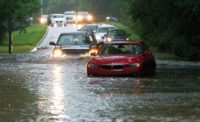Houston's Water Innovation Hub Hopes to Avoid Harvey-Like Near Disasters

Workers install an aqua dam around the flooded backwash pond at Houston's Northeast Water Purification Plant.
Photo Courtesy of Drew Molly
During Hurricane Harvey’s rains in August, engineer Drew Molly and his colleagues at the Northeast Water Purification Plant in Houston waded through hip-deep water, did some quick calculations and with the help of a contractor — and at the behest of the city’s mayor – kept the plant operating and the city’s water system safe with just hours to spare.
It’s a heroic act that Molly and others in Houston want to avoid repeating. They hope to introduce new solutions to help advance new water ideas and demonstrate cutting-edge technologies at full scale. The Water Innovation Hub, a collaboration between the city and a non-profit called Accelerate H20, created just before Harvey struck, was formally kicked off in early December with a focus on resiliency. Hub personnel have already issued a call for skid-mounted, independent water treatment units, and throughout the next year will seek and evaluate new water technologies that can treat and produce water immediately after a flood or other disasters.
While water utilities often test or demonstrate new technologies, those behind Houston’s Water Innovation Hub believe it is the first time that one U.S. city will serve as a hub for multiple ideas.
“Through the innovation hub, new or improved tech might make us less susceptible to a storm,” says Carol Haddock, Houston’s acting public works director. “How do we have infrastructure that is less susceptible to failure?”
Maybe, Haddock says, the hub will help bring to market backwash filters that would require cleaning less often, thereby avoiding the near-disaster that occurred at the Northeast plant. The backwash pond at the plant flooded during Harvey, making it impossible to clean the drinking water filters. While the city’s other drinking water plants also experienced flooding, the Northeast plant was the only site critically inundated.
Molly calculated he could prolong the life of the filters by reducing the plant’s output to 25%. That was the minimum amount needed to keep water pressure in the system sufficient to prevent a boil water notice. Just in time, Peck Boswell, CEO of BRH-Garver Construction, made it through the high water to the site on Aug. 29 and installed a temporary aqua dam around the backwash pond. Crews deployed pumps to drain floodwaters, enabling access to the pond to clean the filters.
Haddock credits Molly’s clear head during the emergency to help keep the drinking water system operational. “Drew has the skills and leadership, as well as the critical thinking of an engineer,” Haddock says. But next time, Molly, who was promoted to oversee the city’s drinking water operations after Harvey, might not be on site, she says.
A New Approach
Houston’s Water Innovation Hub was already in the works before Harvey, says Richard Seline, director of the Houston-based non-profit Accelerate H20, which had already been helping to identify new technologies, products, services and solutions for water and wastewater in Texas and throughout the world.
When the city of Houston was considering major changes in the design and management of its water and wastewater system early last year, it approached Seline’s organization to help ensure Houston was considering all options. Accelerate H20 and the city agreed to create a hub to bring together academics, companies in the water industry and utilities to demonstrate and prove out new and emerging technologies. Seline says his organization will act as a neutral third party to bring in proven technologies from around the world but not yet permitted in the U.S.; growth technologies that haven’t yet been demonstrated at a full scale; and breakthrough technologies that have the promise of a reducing costs, chemicals, energy or other differentials by 20 percent or more.
“We are not being prescriptive,” Seline says. “We are saying these are our problems, bring us everything and anything.” Haddock hopes that testing new technologies and ideas in the real-world setting of Houston – the fourth largest city in the nation – will shave years or perhaps decades off the time needed to bring new concepts and products to the market.
The projects will be financed through a combination of tax credits, sponsorships, grants and by companies that want to try out their technologies at full-scale for business development, Seline says.
As Hurricane Harvey approached, the hub put out a call for skid-mounted, portable and energy independent wastewater treatment units to use if Houston’s facilities flooded. Seline said they secured some of the units, but the response was “underwhelming” and the units ultimately weren’t used.
The experience taught the hub there isn’t a readily available storehouse of water and wastewater equipment that can be sent to areas of need after a storm. Consequently the innovation hub is now looking to stockpile some equipment, including those skid-mounted units, for future storms. The next task is to evaluate other equipment that can be operational within 12-24 hours of a storm or other disaster. The hub is also looking for innovations that will help reduce system failures, and address “resilience strategies for 21st Century communities and industries.”
Molly expects the hub will also be able to help Houston best use new technologies such as smart sensors and gauges to help craft dynamic forecasting models that will better predict floods and rainfall.
“This is not the last time that it is going to rain in Houston,” Haddock says. “It’s not the last time it is going to rain a lot in Houston.”





